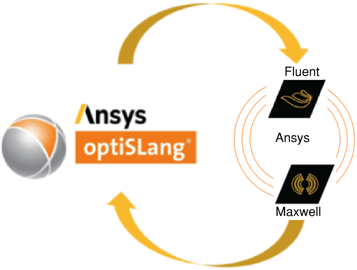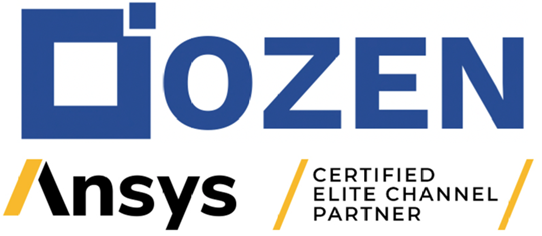Ozen Engineering has experience developing 2D and 3D simulation models of utility power cables to determine the ampacity of cables arranged in installations not covered in the code (NEC) or standards (IEC, IEEE). Finite element solution methods must be used for any case that is not covered by the code or standards, and there are many cable installations that do not have a good standard. Here are several examples of these scenarios:
- Cables of different size and carrying different load in tunnels (no standard).
- Cables in trays (ladder, solid bottom, covered and uncovered)
- Cables in riser poles (vented or not)
- Cables in troughs
- Cables in J tubes
- Fire protected cables
- Duct banks with large aspect ratios
- Duct crossings
- Multiple duct banks
- Bentonite in ducts
- Ducts in tunnels
- Cable Joints
- Cables with rain
- Busbars
- Longitudinal flow
- Cooling/heating pipes around duct banks (IEC can do directly buried cables including nearby pipes)
- Soil has several layers of different materials
The power cable geometry can be imported into an Ansys design using a CAD file or created using CAD operations. Model objects typically include the cable and layers (such as single-core, trefoil, or three-core) as well as ducts, tunnels, backfill, and soil. Material properties can be determined from the NEC code, standards such as IEEE or IEC, or from manufacturer specification sheets. We use industry-based material libraries and our multi-physics simulation capability to make guided technical decisions in the design selection process. We have substantial experience and knowledge to produce high quality meshes and ensure that challenging CFD simulations converge. Thermal boundary layers are computed, and meshing techniques are applied to increase mesh quality while minimizing the number of mesh elements.

Example of a multi-conductor power cable modeled in Ansys simulation tools.
We apply heat sources to the model using standard equations (NEC, IEEE, or IEC) or using ac/dc ratios and loss distributions given by cable specification sheets. The heat source equations used in the standards were derived from electromagnetic theory and applied to heat transfer theory. We solve for electromagnetic losses not covered in the standards using Ansys Maxwell coupled with Ansys Fluent for CFD analysis in a co-simulation. We apply power cable load factors and load cycles with user defined datasets. Determination of power cable ampacity is a multi-physics task. Maxwell’s equations are the governing EM equations to compute the power losses (heat generation) due to
- Eddy effects (skin and proximity effect) in conductor cores, sheaths, armors, ducts or pipes.
- Dielectric material (insulation).
The losses are applied in the conservation of energy so that power loss in the cable, heat generated via conduction, is equal to the heat transferred out of the cable. The Navier-Stokes equations are the governing fluid flow equations to determine fluid flow in convective heat transfer and these are solved using CFD. Conjugate Heat Transfer solvers are used when there is conductive and convective heat transfer in the model. Surface-to-Surface Radiation is used when there is radiative heat transfer in the model. The three modes of heat transfer are
- Conduction: heat transferred out of solid objects (cable and layers, enclosure walls)
- Convection: heat transferred by fluid (air, water, oil, etc.).
- Radiation: Heat transferred by between surfaces (cables, enclosure walls, etc.).
The most important design and installation parameter is the external thermal resistance which include thermal properties between the cable surface and the ambient air (air or other fluid within cable enclosure, duct walls, tunnel walls, soil, backfill, ocean water, etc.). Finite element models do not require using an equivalent (effective) external thermal resistance, and can realistically represent underground material such as soil or backfill with varying thermal properties.
The second most important design parameter is the sheath bonding type. Solid Bonding is always used in the USA. Other countries may use Solid Bonding, Cross Bonding, or Single Point Bonding.
Ampacity of power cables depend on the specific installation and operation conditions such as
- Ambient temperature
- Cable installation depth (if buried)
- Conductor size and material
- Cable layers and materials
- Number of cables (loads) and proximity between cables
- Solar radiation
- Enclosure clearances
- Ventilated (forced convection) or non-ventilated (free convection)
Regarding optimization and robust design solutions, there is a need for efficient optimization techniques which can offer data-driven exploration of the design space while utilizing multi-physics simulation. The power cable system design space is large with complex interactions. Our use of Ansys OptiSLang enables:
- Class-leading multi-physics power cable system optimization
- Traceability on design decisions and data-based trade-off analysis
- Efficient multi-objective design optimization and fast response to changing requirements
- Robust design insights
- Ratio based geometry templates

Ansys tool chain for power cable ampacity optimization.
ABOUT OZEN ENGINEERING INC.
Ozen Engineering is a leading provider of Ansys solutions, catering to a diverse range of industries with a specialization in electronics, semiconductor, biomedical, healthcare, aerospace and automotive applications. Our team delivers personalized solutions to optimize product design and performance by seamlessly integrating Ansys simulation into the product development process. As an elite channel partner of Ansys, we provide best-in-class software tools, consulting, training, mentoring, and technical support.
Contact us to learn about our simulation capability and request a demonstration for us to show you how we can help you with your engineering projects. Ozen Engineering Inc is an Ansys Elite Channel Partner, and we provide training to use Ansys tools, offer consulting services, and sell Ansys software packages.
Visit our website
Give us a call
Send us a message

Tags:
CFD, Thermal, Fluent, Ansys Maxwell, heat transfer, Utility Tunnel, Ampacity, Power Cable, IEC Standards, IEEE Standards, NEC, Cable Rating, Trefoil Cable, Three Core Cable, Single Core CableJan 23, 2024 2:19:04 PM
